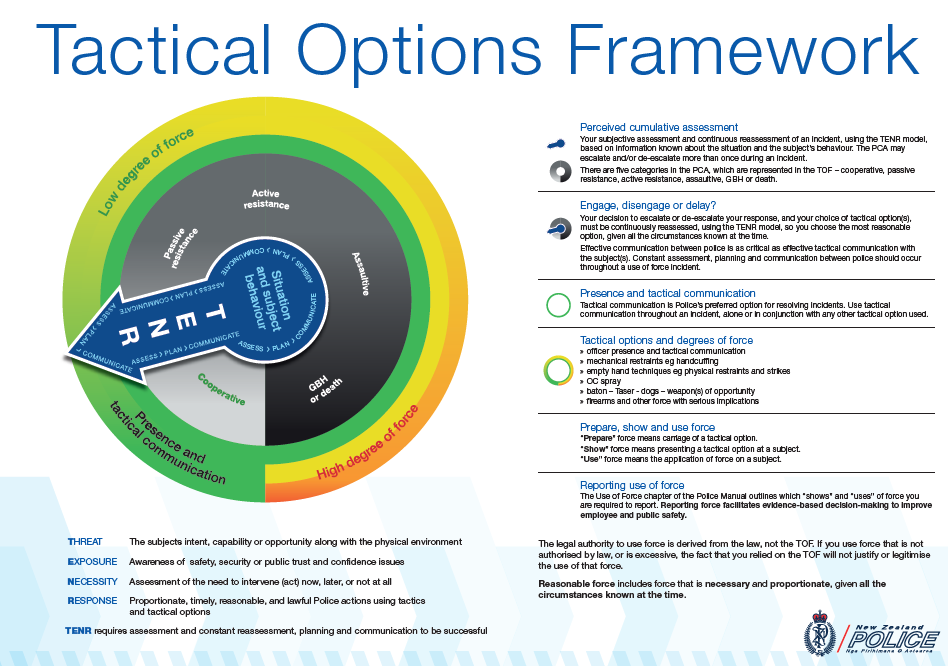

IR-01-24-18603
24 June 2024
Malcolm Daniel
[FYI request #27034 email]
Tēnā koe Malcolm
Request for information
Thank you for your Official Information Act 1982 (OIA) request dated 28 May 2024. You
wrote:
If reference to the policy manual on Mechanical Restraints and the Use of Force
Review.
They describe a pain compliance technique and refer to not using pain
compliance on plastic hand cuffs , but does not mention metal handcuffs The
mechanical restraints policy refers to minimum force. They also refer to filing
TOR reports needing to be filed.
This gives several questions.
1) The mechanical restraints policy has contradictory information around the use
of pain compliance able to be used on plastic handcuffs. In on part is says it cant
be used and in another says a TR report must be made when used. Will this be
resolved ?
The Mechanical Restraints chapter of Police Instructions does mention metal handcuffs:
You must submit a TOR form if you use:
•
metal or plastic handcuffs, a waist restraint belt, and a vehicle leg
restraint:
•
with pain compliance
•
without pain compliance, but only when handcuffs, waist restraint belt,
and/or vehicle leg restraint are used with another reportable tactical
option.
This means that if a person is handcuffed with either metal or plastic handcuffs, and pain
compliance techniques are used, then a Tactical Options Report (TOR) must be
submitted; and that if metal or plastic handcuffs are used without a pain compliance
technique, but with another different restraint option such as a waist restraint belt, or
vehicle leg restraint, then a TOR must be submitted.
It’s not that using plastic handcuffs with a pain compliance technique would be against
policy, but rather plastic handcuffs are not used as a pain compliance technique.
Therefore, police staff would not find this policy to be contradictory.
Police National Headquarters
180 Molesworth Street. PO Box 3017, Wellington 6140, New Zealand.
Telephone: 04 474 9499. Fax: 04 498 7400. www.police.govt.nz


However, I do understand how the risk factor information could appear ambiguous from
your perspective, so I have arranged for the wording used in that part of Police
Instructions to be reviewed, so that it is clear that plastic handcuffs are not used as a pain
compliance technique (which is different from using them with a pain compliance
technique).
2) What manual covers the use and regulation of this compliance technique more
fully ? For example what is minimum force in pain compliance and when is it
allowed to be used?
The definition of minimum force used is from the Crimes Act 1961, Section 39: Force
used in executing process or in arrest1, and is described as such force as may be
necessary to overcome any force used in resisting such execution or arrest.
While there is not a specific chapter of Police Instructions for each use of force technique
available to police staff, for all decision-making about whether to use force, Police uses a
threat assessment methodology called TENR.
TENR is a tool that enables better decision-making where: T - the threat is assessed, E -
the exposure is managed, N - the necessity to intervene is considered, R - and any
response is proportionate, and based on a considered risk assessment of threat,
exposure, and necessity.
Along with the two chapters of Police Instructions you have referenced, Use of Force:
Overview and Use of Force: Mechanical restraints2, the chapter about TENR is also
relevant to your request.
The TENR: Operational threat assessment chapter is publicly available on the Police
website3.
TENR is a decision-making process that supports the timely and accurate assessment of
information directly relevant to the safety of Police and others. The response to any given
situation must be considered, timely, proportionate, and appropriate.
The overriding principle when applying TENR is that of 'safety is success'. Victim, public
and employee safety are paramount, and every effort must be made to minimise harm
and maximise safety.
The Perceived Cumulative Assessment (PCA) is used to inform police’s decision-making.
The PCA is the officer’s subjective assessment, and continuous reassessment, of an
incident, using the TENR model, based on information known about the situation and the
subject’s behaviour.
The officer’s actions determined by their PCA may escalate or de-escalate more than
once during an incident. The officer’s decision to escalate or de-escalate their response,
and their choice of tactical options(s), must be continuously reassessed, using the TENR
model, so they choose the most reasonable option, given all the circumstances known at
the time.
1 https://www.legislation.govt.nz/act/public/1961/0043/latest/DLM328255.html
2 https://www.police.govt.nz/about-us/publication/use-force-police-manual-chapters
3 https://www.police.govt.nz/about-us/publication/tenr-operational-threat-assessment-
police-manual-chapter




There are five categories in the PCA, which are represented in the Tactical Options
Framework, in the grey ring shown in the image below.
3) How is a TOR report obtained by an arrested human or member of the public.
Advice about how to access information held by Police can be found on the Police
website4.
You have the right to seek an investigation and review by the Ombudsman of this
decision. Information about how to make a complaint is available at
www.ombudsman.parliament.nz or freephone 0800 802 602.
Please note that as part of its commitment to openness and transparency, Police
proactively releases some information and documents that may be of interest to the
public. An anonymised version of this response may be publicly released on the New
Zealand Police website.
Ngā mihi
Superintendent Dave Greig
Director Operational Capability
4 https://www.police.govt.nz/advice-services/accessing-information







